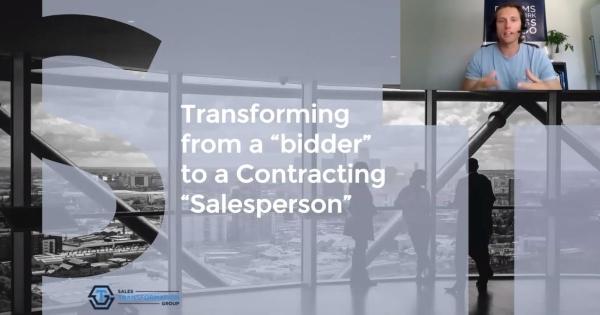Transforming From Bidder to Contracting Salesperson

By Lauren White.
Ryan Groth shares five steps to become a contracting salesperson.
Workers in the construction industry tend to “get work based on some kind of a change in environment or the economy,” according to Ryan Groth from the Sales Transformation Group. As people become familiar with the construction trade and contractors get familiar with finding solutions, that ends up being the majority of conversations, skipping over other important details. Ryan shares steps on how to go from being a bidder, or an order taker, to a contracting person.
Nowadays, it’s more rare to encounter a “high-performing contracting salesperson that can actually make revenue predictable, forecast, and hit really high numbers,” Ryan explains. Being a person who is just an order taker is problematic because it causes you to just be a solution thinker not a seller. According to Ryan, “...when you’re not proactively selling and you’re just picking up work, you’re really...focusing on just getting to the quote because, again, you’re so conditioned to find out what [it takes] to do this waterproofing, roofing, landscaping, you name it.”
In doing this, information gets missed and corners are cut. Quotes and bids are made, but there’s uncertainty concerning the outcomes of the work and investments. In Ryan’s experience working with commercial contractors, a common proposal for a construction project costs about $1,200 for the takeoff, estimate, and proposal. Ryan expresses, “We just spend so much time on finding out what it takes, and money, to bid it, we don’t really do a lot of these other things that real salespeople do, and these real salespeople close at a much higher rate with a much shorter sales cycle, and make a lot more margin in their business.”
Ryan has five steps that can help fix this prevalent problem:
The first step is to determine your environment. Ryan explains that there are two different categories of people, professional buyers and uneducated buyers. The professional buyers, “...schmooze you, they’re nice to you, and then they want to stick you...They’re trying to get you to do everything for as low as possible…” Many people have been conditioned to be in that environment.
The other category, uneducated buyers, are people who simply need help. According to Ryan, “They don’t know...anything about what you do. They don’t think they know anything. They’re not trying to have some kind of intellectual boxing match with you. They just want to solve a problem.” People in this category tend to own existing units, buildings, or facilities. Contractors are able to service, repar, and retrofit in this type of environment.
Ryan recommends choosing the uneducated environment because from there you can start to make things more predictable for your company by understanding your customer. For example, if you’re at the Kentucky Derby, and there’s a horse called, “Always There.” Ryan explains, “I want to bet on that horse...that’s in an environment that’s going to always be there, which is an environment of restore, replace, and people who...need help and they’re not just trying to bid-shop...”
The second step is to dig deeper. Identify weaknesses that are holding individual team members back from selling. In doing this, you gain clarity and your mentality transforms to the bidder-estimator, which is good enough to survive. However, if you want to thrive, a complete transition is necessary.
Third, define success. Many owners share that their goal is to get and do as much work as they can. Ryan calls that the “Wild Wild West.” He challenges owners to put more effort into defining success and deciding what that success looks like at least three years out. By doing that, you can work backwards to develop a plan and make your projected prosperity a reality. Then you know, “on a daily, monthly, weekly basis what [you] ought to do, what’s entailed to make this a reality, and hold people accountable to that,” explains Ryan.
Next, determine a supportive sales process. Many companies start by explaining how great they are and how they’re able to solve a clients need. Ryan encourages companies to have a consultative sales process that focuses on value and, “...teaches folks to really find out more information about the prospect, about the suspect, about the potential client,” and learn more before jumping in to the, “give me a bid” portion of the conversation.
Having a fluid sales process instead of a rigid, robotic one gives people “...awareness and familiarity of where they can support their ability to sell value and be a salesperson rather than just a bidder. A sales process needs to be really focused and milestone-centric around these things,” Ryan explains.
Finally, investing in “ongoing coaching and accountability is absolutely vital,” according to Ryan. With any lifestyle change, having a support group or finding others to partake in the same change helps people get excited and commit to it long-term. Ryan reveals, “What we need to do is foster an environment where those changes are celebrated…” because old habits are hard to break.
An environment of ongoing coaching and accountability will help you get out of the “...old, unpredictable, bid-world, order-taking world…” Ryan points out. Eventually it will become habitual. Ryan shares that, “Tom Brady is one of my favorite athletes of all time. He still has a throwing coach. He’s a six-time Super Bowl champ. He never stops improving...”
These are five steps that can help you start moving away from being a bidder and move toward being a contracting salesperson. Being a seller and not just a solution seeker will warrant better business outcomes. Additionally, following these steps will help you determine weaknesses that are holding you back from selling and also help you define specifically what success means to you. Continuously improving and holding yourself and others accountable will make the transition rewarding for everyone.
For your free 45-minute strategy session with Ryan visit their special RCS promotional page.
Don't miss the weekly videos, join Ryan's YouTube Channel for notifications.























Comments
Leave a Reply
Have an account? Login to leave a comment!
Sign In